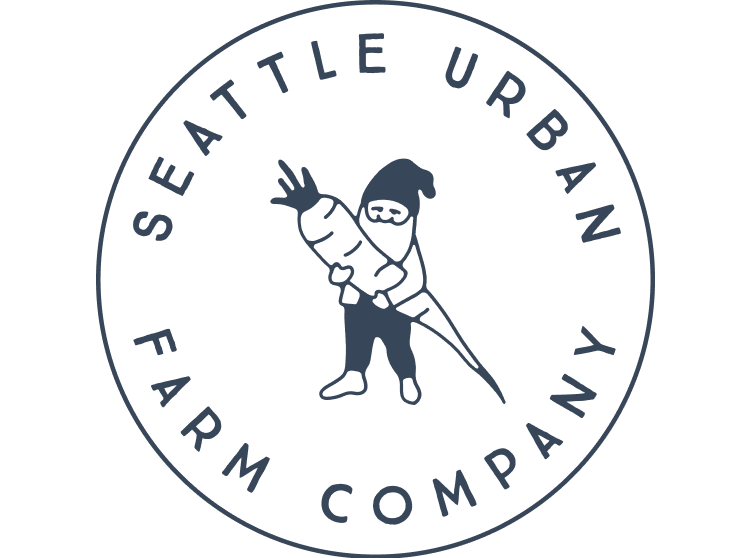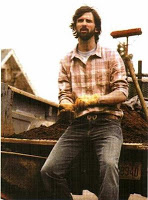You may have noticed that your tomato plants have finally gotten the clue and started to grow a little bit. You may have also noticed that, once they start to grow, they can get out of control pretty quickly...thus the need for trellising and...pruning. Believe it or not, but cutting out some of the branches of your plant will actually result in more, better tasting fruit (and your tomatoes will be less prone to problems such as fungus, mold, drunk driving, etc.). Brad found this article which explains it all very well:
Pruning Tomatoes - Fine Gardening Article
Source: finegardening.com
GQ!??!!!
Is this picture really in the May issue of GQ?
Believe it or not, there is an article called "A Man's Introduction to Vegetable Gardening"...I got a call from an editor at GQ who said "Is it alright if we take a picture of you for our magazine?" and I said "I don't see why not..."
Alice
Not that anybody is keeping track...but I haven't blogged in a while. Not that there has been a lack of fodder...to say the least, the past few weeks have been a whirlwind tour of Leeds England. Spring has come on with a vengeance, intermittent sunshine mixed with rain and warm nighttime temperatures have made this (in my opinion) the best spring in a few years. Things are growing. To further complicate things, SUFCo. has been transitioning into a new headquarters (more about this later)...so we haven't had much time to breath (or play leisure sports). Interesting things have been happening. It seems that everywhere you go, someone is ready to talk about local foods and/or baseball. A couple of weeks ago I was lucky enough to meet Alice Waters at a farmer's market.
I am not sure if I should attempt to explain the importance of Alice in the local food movement. Briefly, she started a restaurant serving fresh, local foods in California Chez Pannise back in the day, way before it was cool. In my opinion, she is certainly one of the most influential food activists in the universe. There is even a great PBS documentary "Alice Waters and Her Delicious Revolution. I picked up a copy of her new book Edible Schoolyard which chronicles the advent of a gardening/cooking program she helped develop at a school in Berkeley. Which is very timely as we are currently trying to work out the details to help set up gardening spaces and curriculum at a few schools around Seattle. Anyways, the point is that she is really cool, and even though she wasn't signing body parts, she did sign my book and seemed like a genuine person.
Kefir
Kefir is a cultured dairy product similar to yogurt, but made with different strains of bacteria. It is more of a liquid substance than yogurt, but has a similar taste. This may not be an essential part of urban farming, but for those with too little time/space for livestock like chickens or goats, this makes a great alternative pet.
It takes about as much time to care for as your goldfish or chia head. The hardest part is getting the kefir grains to begin with. I would recommend one of the following: order it online, or go down to the nearest tea shop and locate someone who is reading tarot cards. Preferably someone wearing a purple scarf and several large medallions (they should know where to get some...)
These are the materials you will need:
Kefir grains
Milk
2 glass jars with lids (I use 1/2 gallon jars but 1 quart works well too; one to ferment the kefir in and one to store the finished kefir in)
A spatula
A colander (not metal, legend has it that contact with metal will kill your grains)
A bowl (preferably one with a spout that pours well).
The steps:
Set the colander into the bowl, open your jar of kefir and pour it into the colander. Use the spatula to push all of the liquid through the colander and into the bowl. Your kefir grains are what is left in the colander once the liquid pours off. Some people say to rinse the grains at this point, but I don't...the last time I tried that, my grains perished...
Pour the kefir liquid into the second glass jar to be stored in the refrigerator or consumed immediately...enjoy your kefir any way that seems appropriate. I would recommend mixing it with your favorite fruit, putting on a very good Boston album ("More Than a Feeling") and reading my blog...
Clean the fermenting jar well and put your kefir grains back in the newly cleaned jar.
If your culture is healthy and is growing too large for your needs, this is a good time to separate out some grains and give them to Steve...
Pour milk into the jar with your kefir grains (and Steve's). You can use whatever milk you like. I would recommend organic, whole, unpasteurized, grass-fed, shade-grown, sustainable, fair-trade, dolphin-safe milk from your local farmer's market...
Put the lids on your jars, put your kefir jar next to Steve's and remember: it is more than a feeling. It is very likely that you will start dreaming, but with any luck you won't have to see your Marianne walking away...
Put your kefir away in a cupboard for one or two days (depending on how fermented you like it), the longer it sits, the more fermented. The whey will start to separate and it may take on a "yeasty" taste. The timing will depend on the quantity of grains that you have in proportion to the quantity of milk you are using...if your kefir goes too long and seems undrinkable, use it for baking or dispose of it and make a new batch. Even if you forget about it for a week or two, the grains should still be alright if poured into a new bath of milk. If you are going out of town for a few weeks, store the grains in milk in the refrigerator. This will allow them to hibernate until you return.
Repeat
Prune Your Fruit
I am not sure if there is a name for slacking on your blog...the last few weeks have been pretty interesting and may necessitate a few blogs to elucidate.
Last Saturday we went to a workshop put on by the Western Washington Fruit Research Foundation (WWFRF). It was held at the Washington State research center in Mount Vernon. You could call it a virtual Who's Who of western Washington fruit tree nerds. We attended talks on soil fertility, grafting, pruning and thinning; followed by demonstrations in the WWFRF orchard. I will do my best to sum up a little of the information I absorbed, but here are a few resources that will really tell you what is what:
Video: Easy Steps to Fruit Tree Pruning, by Gary Moulton
Book: The Pruning Book, by Lee Reich
Book: The Backyard Orchardist, by Stella Otto
We were fortunate enough this past weekend to hear a lecture by Gary Moulton about fruit tree pruning and thinning. Most important to remember: it is important to remember to prune...Also, make sure that you have clean, sharp tools. You will likely need a sharp pair of loppers, a sharp pruning saw and a sharp pair of hand pruners, and a ladder.
There are a few basic shapes that fruit trees are generally pruned into: Central Leader, Modified Central Leader, Open Center and Espalier.
Central Leader: has one main branch going straight up the
middle and other branches radiating out in different
directions around the trunk, called scaffold branches. (see diagram: North Carolina State University)
Modified Central Leader: let the tree start out as a central leader and then either tie down the central leader to turn it into a scaffold branch or head it back. (see diagram: www.urbanharvest.org)
Open Center: cuts out the central leader and develops four or five main scaffold branches headed out in different directions. (see diagram:www.ext.vt.edu)
Espalier: can be trained in very complex patterns, but generally is pruned so there are only branches going in two directions (as if flat against a fence). (see photo: www.ynurserynews.com)
You can choose to train your trees into any of these shapes...the most important thing to remember is to make thinning cuts instead of heading cuts.
Thinning cuts: remove entire branches all the way back to the trunk or main scaffold. Remove branches that are growing in the same direction (competing with each other) or crossing each other. You will open up the remaining branches to air flow and sunlight.
Heading cuts: this is when you cut a branch back part way (cut off the head), it will cause branches to "bush out" at the ends, reducing airflow and sun penetration.
If this seems like a strange time of year to be so focused on fruit (since most won't be ready until the end of summer), you are a fool!
Have you have ever noticed that your fruit tree produces a heavy crop one year and then a very light crop the next year? Most likely it is because you did not sacrifice a yearling goat under the last harvest moon.
Alternatively, it is possible that you have not been pruning your trees properly. If you would like to improve your tree health and balance your yearly fruit production, would strongly recommend eliminating this blog from your memory, doing some real research on your tree varieties and getting out there and starting to prune...and then there is fruit thinning...
Mystery Turnips
First of all I would like to say thanks to everyone who was exposed to the great White House Farmer frenzy last week. Although my name ended up in 14th place, somehow we collected over 700 votes in the span of three days. That is pretty amazing. I am still looking into other strategies to pursue the position (maybe on craigslist?...)
Secondly, and more to the point, I ate the worlds largest turnip this week (please see attached photo)
You see, a few months ago, I was in Latin America doing some "research" on tropical agriculture. In mid-November I was visiting a great sustainable ag. education farm called La Flor de Paraiso in the central highlands of Costa Rica. At the farm, I met travelers from all over the world, and I met a guy from Oregon named Jim.
Evidentally a friend of Jim's had been looking for the seeds of an old heirloom turnip grown back in the days of their grandparents. No seed company or seed saving organization had the seeds in question. Then they found an old jar of the seeds in just sitting on a windowsill in grandmothers house! As fate would have it: the seeds were still viable; some of the seeds were passed on to Jim; Jim promptly grew the turnips; and Jim let them go to seed while he travelled to Costa Rica. I can admit a little skepticism when Jim told me in his plain-speaking manner:
"These are the biggest turnips you've ever seen."
In fact I hadn't seen that many turnips for comparison, but I gave Jim my mailing address, hoping one day to get my hands on some of these rare seeds. Not two months later I recieved a mysterious package in the mail, originating in Oregon and weighing approximately 400 lbs. (hyperbole) Inside I found a package of seeds and the biggest turnip I've ever seen.
After posing for some glamour shots with the turnip, I proceeded to slice off 5-10 lb. pieces to give away as Groundhog's Day gifts to my closest friends. The remainder was cubed, roasted and integrated into my Winter Root Crop Consumption Program (WRCCP). It turned out to be very good eating.
As you can imagine, we are greatly looking forward to sowing, growing and collecting these turnip seeds (scientific name unknown) and hopefully disemminating some next spring on Pennslyvania Avenue... Thanks Jim!















